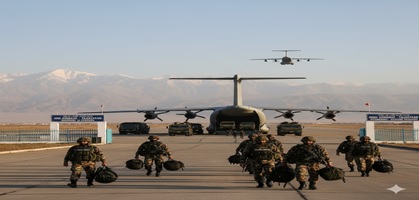13 October, 2025
India Withdraws Its Forces from Ayni Airbase in Tajikistan
Sun 02 Nov, 2025
Context:
- India officially ended its operations at the Ayni Airbase in Tajikistan after nearly 25 years.
Key Points:
- This was India’s only overseas military base, active for about 25 years (2002–2022).
- The Ministry of External Affairs (MEA) confirmed that after the expiry of the bilateral agreement, the facility was handed over to Tajikistan.
- The base was originally built during the Soviet era, but fell into disrepair after the Soviet Union’s dissolution.
- Indian collaboration: India, under a 2002 bilateral agreement with Tajikistan, spent about USD 100 million to modernize and reconstruct the base.
- Strategic use: Located near Afghanistan’s Wakhan Corridor, the base served as a logistics, intelligence, and air support hub for India in assisting the Northern Alliance against the Taliban.
- Recent use: After the Taliban took over Afghanistan in 2021, India used the base to evacuate its citizens and officials.
Reasons for Withdrawal:
- End of Bilateral Agreement: The deployment agreement between India and Tajikistan expired around 2021–2022 and was not renewed.
- Reduced Strategic Utility: After the Taliban’s full takeover of Afghanistan, the Northern Alliance lost its relevance, diminishing the base’s strategic importance.
Strategic Importance for India:
- Ayni was India’s only foreign military base.
- It provided India a strategic presence in Central Asia.
- Located 20 km from Afghanistan’s Wakhan Corridor and close to Pakistan-occupied Kashmir (PoK).
- In the late 1990s–2000s, it served as India’s logistical hub for anti-Taliban operations supporting the Northern Alliance.
Ayni Airbase (Also known as Gissar Military Aerodrome)
- Other Name: Gissar Military Aerodrome
- Location: About 10–15 km west of Dushanbe, the capital of Tajikistan
- Background: Originally a Soviet-era airbase, it became inactive during Tajikistan’s civil war in the 1990s.
- Indian Role: India revamped the airbase in 2002 with an investment of approximately USD 70 million (₹500 crore).
- Proximity: Strategically important due to its closeness (about 20 km) to the Wakhan Corridor, linking Central Asia with South Asia.
Tajikistan
- Location: A landlocked country in Central Asia.
- Capital and Largest City: Dushanbe (meaning “Monday” in Tajik, as it originated as a Monday market site).
- Geography:
- About 93% mountainous region.
- Home to Pamir and Tian Shan mountain ranges — often called the “Roof of the World.”
Borders:
- North: Kyrgyzstan
- West: Uzbekistan
- South: Afghanistan
- East: China
- Distance from India: Separated from India by the Wakhan Corridor of Afghanistan, making it geographically close to India.
- Official Language: Tajik (a Persian dialect written in Cyrillic script); Russian is also widely spoken.
- Religion: Majority follow Islam (mainly Sunni branch).
- Culture: Influenced by Iranian, Persian, and Central Asian traditions; bread (naan) is considered sacred, and the national dish is Plov (rice with meat and vegetables).
- Historical Links: Believed to be the ancient site of Kamboja and Parama Kamboja mentioned in Indian texts — reflecting deep cultural and historical ties with India.
- Political System: A republic, gained independence in 1991 after the collapse of the Soviet Union. Experienced a civil war (1992–1997) post-independence.
- Currency: Tajikistani Somoni (TJS)
- Major River: Syr Darya, lowest point at about 300 meters.
- Industries: Aluminum production (among world’s top), cotton, and fruit farming (cherries, apricots).


















